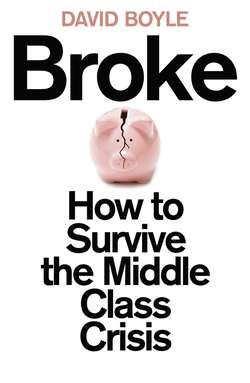Читать книгу Broke: Who Killed the Middle Classes? - David Boyle - Страница 10
Dispatches from the Frontline
ОглавлениеBrown & Green café, Crystal Palace station, Friday 10.30 a.m.
Gipsy Kings waft out of the digital player behind the counter, over the luxurious sound of sizzling bacon. This is an English scene, with all the luxury of a late breakfast when everyone else is at work, but with a Latin American edge.
The middle-class newcomers to Crystal Palace, high on the hill above south London, are generally pretty oblivious to the culture they are displacing – which is anyway on the exhausted side. Since the original Crystal Palace building, designed by Joseph Paxton, burned down so spectacularly in 1936, nothing much has changed around here except for the closure one by one of the public toilets and the slow march of gentrification, as confident and as doubt-free as the Plantation of Ulster.
So there has been a flurry of excitement locally about the opening of this café, run by the televisual Laura and Jess who have made such a success of the café in the next station down the line. Even so, there are not so many people here at our odd collection of rescued 1960s tables, with the red Formica tops and strange tapering legs, hallmarks of an alien civilization.
The usual herds of buggies that clutter up middle-class cafés in the mornings these days are conspicuous by their absence. Instead there is a whole collection of black cocker spaniels, with their owners. One of them turns out to be called Peggotty, a distinctively middle-class literary reference (David Copperfield).
There is also a mixture of class symbols in this café, with its tomatoes being chopped behind the counter and the carrot cakes sweltering above it. The blackboard advertises porridge with seeds, honey and yoghurt. I am drinking green tea as if it were going out of fashion. The walls have been whitewashed. Aluminium saucepans hang from the ceiling (do they ever use them?). On the blackboard above me are the lines from The Sound of Music about climbing every mountain (we know from Mike Savage’s research (see page 44) that the working classes never go to musicals, so this is as clear a sign that we are in middle-class territory as anything else).
Yet dotted around are also the traditional symbols of working-class café life – rusty old signal lamps, third-hand furniture, and here in front of me a tomato-shaped plastic dispenser for ketchup, straight from the 1960s. It is as if the symbolism of working-class culture in another age is a reliable sign that this is not nouvelle cuisine and the helpings will be encouragingly and comfortingly generous.
Crystal Palace station, with its vast echoing staircases, was built to handle the crowd for FA Cup finals (100,000 people in 1900), which were played here until the advent of Wembley Stadium. The huge Victorian windows of this reclaimed station were the very centre of working-class culture in south London. Yet here we are in 2012, eating our scrambled egg on rye.
‘No, she’s not pushy,’ says Peggotty’s owner behind me. ‘She’s shy and retiring. Just like me.’
